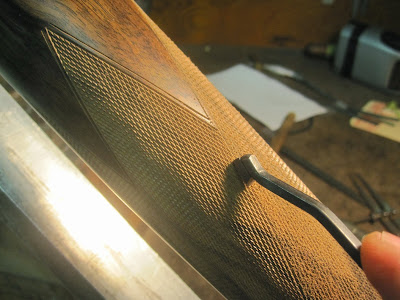I always lay out the cheek piece side first so the rear tail of my point pattern allows for the termination of the cheek piece. To do otherwise is just asking for trouble as the end of your pattern may cut into the end of your cheek piece if done from the other side first. I cut in both master lines on both sides of the grip once I am happy with the looks and position of this intersection. I do not establish any other borders but rely on the lines to be cut in eventually to determine the end or border of the pattern. Like the forend I will lightly scribe in some reference lines to keep me honest as the lines wrap around the curves of the grip. Many people comment on how "straight" the lines appear on good checkering which I find quite comical. What you see in a good pattern is well spaced parallel lines that are then following a parabolic curve in most cases, straight? Not hardly. I also place two layers of tape on the back side of the grip panel to prevent any cutters from accidentally scratching the stock behind the pattern in this tight area.
I lay out both sides of the grip and then as with the forend establish the ends of the major points so their lengths are optically pleasing. Then I cut in the borders except for the shortest borders on the leading edge of the pattern, don't ask me why I save those for last as I'm not sure I could tell you. Then starting with the 75 degrees cutter I deepen the pattern on both sides with two passes. Once this is done I begin the final deepening with a 90 degree cutter. In tight corners I use a short corner cutter or the veiner. At this stage of the process I have 42.5 solid man hours in this checkering project and I'm are not done yet.


























